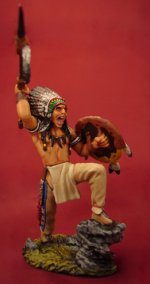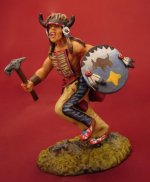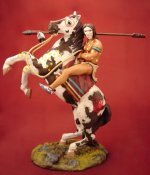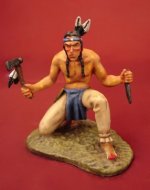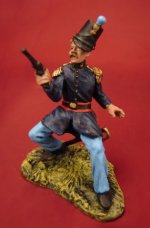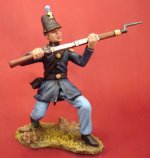The Grattan Massacre took place on August 19, 1854. It occurred east of Fort Laramie, Nebraska Territory, USA, now in present-day Goshen County, Wyoming, when thirty U.S. soldiers and a civilian were killed by Brulé Lakota (Sioux) after one of the soldiers had shot their Chief Conquering Bear in the back. It was an early and significant event in the plains Indian Wars.
[edit] Details
In the late summer of 1854, about 4,000 Brulé and Oglala were camped near Fort Laramie in accordance with the terms of the Treaty of 1851. On August 17, a cow belonging to a Mormon traveling on the nearby Oregon Trail was killed by a Minneconjou named High Forehead. Lt. Hugh Fleming, the senior officer at the fort, called on Conquering Bear, so that the matter could be discussed. Lt. Fleming was evidently unaware, or chose to ignore that matters of that nature were, by the terms of the Treaty of 1851, to be handled by the local Indian Agent, in this case John Whitfield, who was due to arrive within days. Conquering Bear, however, was fully aware that the matter should not concern the military, but he still attempted to negotiate, and did not consider the matter serious. Conquering Bear offered the cow's owner his choice of any of his 60 horse herd. The owner refused, demanding $25 instead. Lt. Fleming demanded that the Sioux arrest High Forehead and deliver him to the fort, to which Conquering Bear refused. That days negotiations ended with no result.
The next day, Second Lieutenant John Lawrence Grattan, of the U.S. 6th Infantry Regiment, a recent graduate of West Point, was allowed to lead a detachment into the Indian encampment to bring in the guilty Lakota cow-killer. Grattan was an inexperienced, short-tempered young man, openly contemptuous of the Lakotas' ability as warriors and who was looking to prove himself. This would be his first interaction with the Sioux. A commander at Laramie later recalled, "There is no doubt that Lt. Grattan left this post with a desire to have a fight with the Indians, and that he had determined to take the man at all hazards." Grattan took with him a sergeant, a corporal, 27 privates and a French-American interpreter named Luciene Auguste, along with two artillery pieces.
By the time the detachment reached the Indian encampment, Auguste was intoxicated, and Grattan broke the translators bottle against his saddle. Had Lt. Grattan taken charge of Auguste at that point, and sent him back to the fort, it may have prevented tragedy[original research?]. Instead, Lt. Grattan scolded him, and continued on. Auguste was not well liked by the Sioux, and spoke only broken Dakota, with his other dialects being poor to nonexistent. As they entered the encampment, he began to taunt the Sioux, calling their warriors women, and stating that the soldiers were not there to talk, but to kill them all. A local trader and trading post owner, James Bordeau, later recounted those facts.
It is estimated that the encampment as a whole had some 1,200 warriors out of the total 4,000 or so total population. According to Bordeau, Lt. Grattan did begin to realize his situation, and stopped to discuss this with Bordeau, who was there trading. Bordeau advised Grattan to speak directly with Conquering Bear and let him handle the situation in his own way and in his own time. Lt. Grattan seemed to grasp that concept, and continued on into the encampment. However, he first located the lodge of High Forehead, and ordered his surrender. High Forehead refused, saying he would die first.
Lt. Grattan then approached Conquering Bear, insisting that the Sioux should arrest the guilty party and turn him over. Conquering Bear refused. However, Conquering Bear did understand the nature of the situation and tried to negotiate, but Lt. Grattan continued to escalate tensions. The problem was undoubtedly made worse by the interpreter Auguste, who continued to taunt the Sioux, and seemingly mistranslated some of what Conquering Bear said, as well as what Lt. Grattan said, as there seemed to be some confusion. Conquering Bear asked that the trader, James Bordeau, be brought to translate, as they trusted him and his language skills were excellent. Bordeau was notified by the Sioux, and he did ride forward to the meeting place, however he would later say that he could quickly see that the matter had gotten out of hand, as Lt. Grattan was openly defiant of Conquering Bear, and Bordeau could see the Sioux warriors moving into flanking positions around the soldiers. Seeing this, Bordeau departed and returned to his trading post, where he told his fellow traders to arm themselves, as a fight was coming.
Lt. Grattan evidently tired of the negotiations, and undoubtedly had noticed that his small detachment was in a bad position. He concluded the negotiations, and began walking back to his column. When Conquering Bear stood up, he was shot in the back and killed by a soldier, while another soldier fired into a group of Indians nearby, wounding one. This started a volley of fire from both sides; Grattan and the 30 men with him were quickly wiped out, with Lt. Grattan being one of the first killed. A group of some 18 soldiers did break away in an attempt to reach a small group of rocks so that they could form some sort of a defense, but were cut off and annihilated by warriors led by Red Cloud, then an up and coming war leader within the Sioux.
Conquering Bear was the only Lakota who was killed. This event was called the "Grattan Massacre" by the U.S. press as part of a campaign to stir up anti-Indian sentiment. The fact that Lt. Grattan had instigated the event, as well as the fact that the army should never have involved itself in the situation was ignored in the press. News of the fight reached the War Department and plans were put into motion for retaliation. William S. Harney was recalled from Paris and sent to Fort Kearny, where he was put in command of elements of his own 2nd US Dragoons. They set out on August 24, 1855 to find and exact retribution on the Sioux.
Michael
